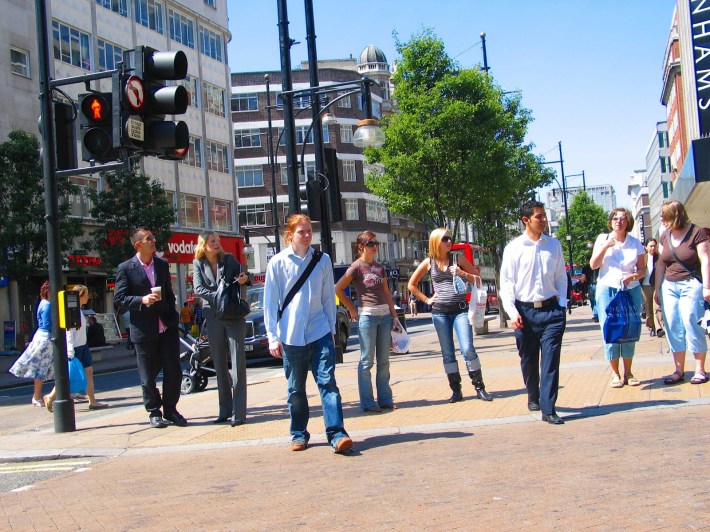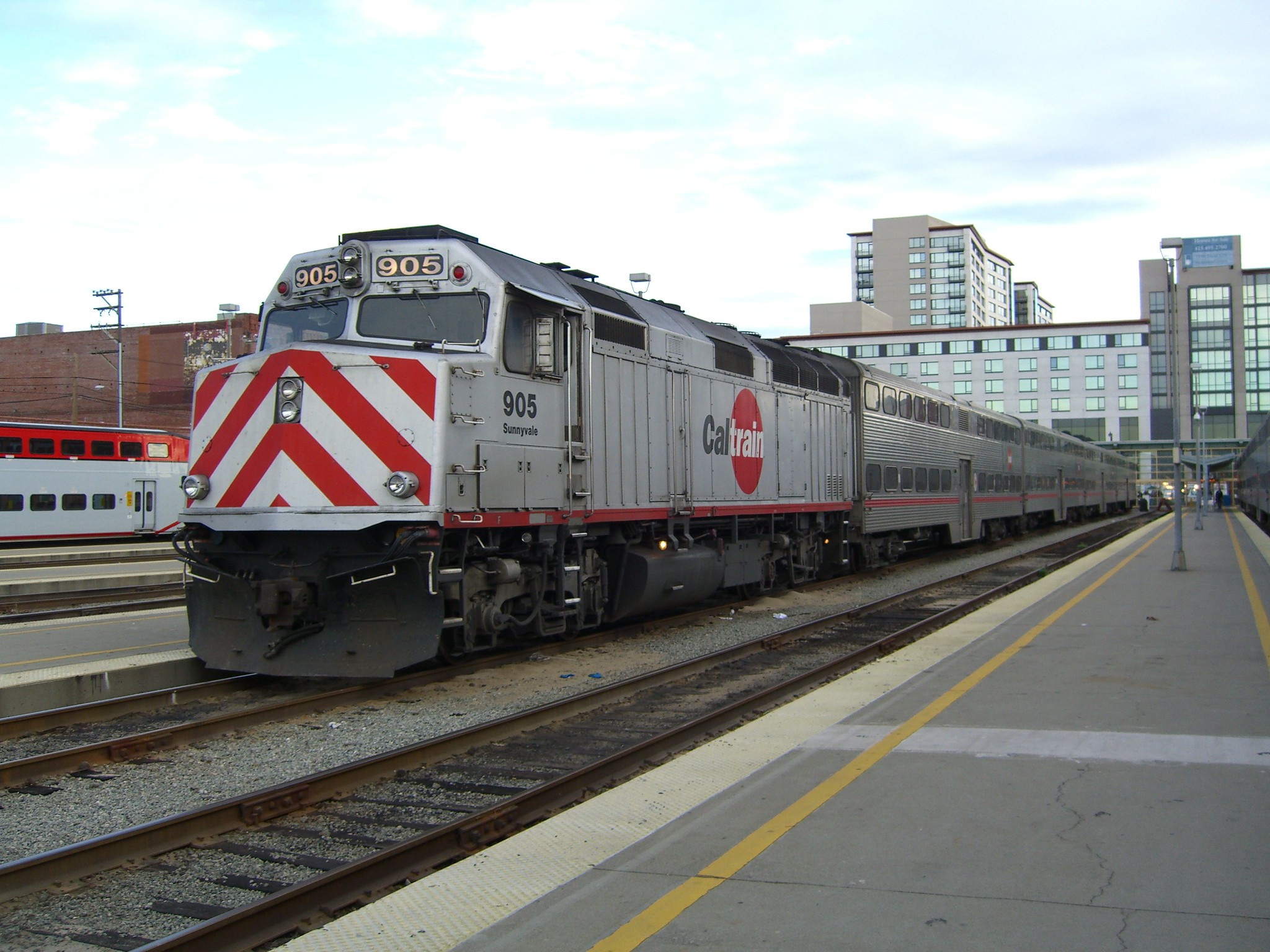A “Movement For Movement” Puts Walking Front and Center
2:01 PM EST on December 6, 2012
Six weeks after my daughter was born, my midwife asked me if I was getting any exercise. I confessed I wasn’t. I hadn’t figured out a new routine that included exercise, my old activities weren’t baby-friendly, I just didn’t have the time, and I wasn’t up for anything high-impact.

She recommended I try walking for 20 minutes a day.
“Oh that,” I said. “I do that.” As a car-free family with a baby too little to ride a bike, all we ever did anymore was walk – far more than 20 minutes most days. It just hadn’t occurred to me that it counted as exercise.
This “unintentional walking,” as walkability evangelist Chris Leinberger calls it, is the key to getting more people active. At a day-long conference yesterday on pedestrian advocacy, Jane Ward of the George Washington School of Public Health made this sensible point:
We can’t be successful with the majority of the population if walking is something stuck on to a list what people are already doing. I think most people know that they should be getting more exercise, but if they think they have to make time in their already too-busy day, they’re not going to do it.
So, I think to focus on the useful walk, and walking as active transportation that should have equal consideration in transportation planning, with all other modes of transportation, is the way that we will reach the most people.
Yesterday’s conference was sponsored by a diverse group: the health care provider Kaiser Permanente, the American College of Sports Medicine, the Safe Routes to School National Partnership, Everybody Walk!, and America Walks. It was held at Kaiser’s DC headquarters, home to a huge, two-sided, interactive digital wall with information on walking.
Walking’s health connection can’t be overstated. “Being physically active is the most important thing all Americans of all ages and weights can do for health,” said Joan Dorn of the Centers for Disease Control and Prevention. “We recognize the benefits of all kinds of physical activity, but we picked walking as an area on which to focus because it’s something that almost all Americans can do.”
A person’s risk of developing chronic health problems like heart disease, type 2 diabetes, and high blood pressure rises with inactivity. Walking can help people lose weight and can help seniors prevent falls. And it can do some things no one would expect.
Bob Sallis of the American College of Sports Medicine tells the story of Valerie, a patient with Parkinson’s disease. “She came in on a walker,” he said, “extremely frail, obviously depressed.” She had tried every medication and had just about given up. Sallis convinced her to see a fitness professional who started her walking on a treadmill at 1 mph. At first, they had to hold onto her.
Three weeks later she came into Sallis’s office “without the walker, makeup on, a completely different patient.”
“She had been transformed just by getting out and walking,” Sallis said. “And it occurred to me: If this had been a pill or a surgical procedure, this would have been on 60 Minutes. Everybody would have wanted to get a hold of this pill that so transformed this patient.”
Stories like this help you understand why Sallis’s motto is: “Exercise is medicine.” His crusade is to get physicians to write prescriptions for a 30-minute walk as readily as they write a prescription for Lipitor.
While 62 percent of adults reported walking either for leisure or transportation in 2010, up 6.3 percent from five years before, only 48 percent of adults meet federal guidelines for physical activity.
Walking has many benefits beyond health. As Tyler Norris of Kaiser’s Center for Total Health put it: “It is said that a good solution solves many problems -- and walking is a good solution.” To make that solution work, much of the disastrous urban planning of the post-war period will have to be reversed. Planner Jeff Speck brought that point home, reading an excerpt from his new book, The Walkable City:
City engineers, worshipping the twin gods of smooth traffic and ample parking, have turned our downtowns into places that are easy to get to but not worth arriving at. Outdated zoning and building codes, often imported from the suburbs, have matched the uninviting streetscape with equally antisocial private buildings completing a public realm that is unsafe, uncomfortable and just plain boring.
Planners are coming around, Speck said. They were 20 years behind urbanist pioneer Jane Jacobs, but by 1980, most planners understood the importance of walkability. The problem is, he said, “the planners were so wrong for so many years that now that they’re mostly right, they’re mostly ignored.”
With the U.S. population expected to grow by 100 million people over the next 40 years, the scope of the problem is urgent. The idea that all those people will be accommodated by building more highways is dangerous. The country needs to invest in more efficient means of mobility.
Walking is also the great social equalizer. Gil Peñalosa of 8-80 Cities made this impassioned (and poetic) plea:
Walking, as well as cycling, is not a joke. This is not a frivolity. It’s the only mode of individual mobility for children and youth all over the world -- and for most adults as well. So walking should be a human right, unless we think the only people who have the right to individual mobility are those who have the money and the age to drive cars.
And finally, I think the social issue of equality is tremendously important. We see nice sidewalks here [in Washington, DC]. But in most cities across the U.S., we see beautiful roads and horrible sidewalks, full of barriers and different levels and posts and broken and dangerous intersections. So we are constantly telling people, implicitly, the pedestrian is a second-class citizen. So in the back of their minds, the people that are walking are always thinking, ‘Someday, I’m going to have a car.’
So we have to have fantastic walking facilities, half because it’s going to be safe and the other half because we need to dignify the pedestrian.
The gathering at Kaiser was part of a growing advocacy effort focused on walkability. Last week, Sam Schwartz Engineering and America Walks launched Walksteps.org, the online home of their new guide, Steps to a Walkable Community: A Guide for Citizens, Planners, and Engineers, full of “pro-walking tactics and case studies that have successfully improved and encouraged walking in communities around North America.” The working groups at yesterday’s conference are expected to meet again in January, and a national conference is being organized for next fall.
Stay in touch
Sign up for our free newsletter
More from Streetsblog USA
Talking Headways Podcast: Highway Fighting in Texas
Jeff Wood talks to Megan Kimble about an amazing footnote to the creation of the Interstate Highway system.
The Dawn of the ‘Non-Driver’ Movement: A Conversation with Anna Zivarts
"At the end of the day, there are going to be folks who still can't drive and can't afford to drive — and there are still going to be a lot of us."
Thursday’s Headlines Fight a Suburban War
The way Politico lays out the battle lines, it's not just drivers versus transit users, but urban transit users versus suburban ones.
California Leaders Celebrate Ten Years of Climate Action
Air Resources Board report highlights progress funded by the California Cap-and-Trade Program.
How Car-Centric Cities Make Caring For Families Stressful — Particularly For Women
Women do a disproportionate share of the care-related travel their households rely on — and car-focused planning isn't making matters easier.




